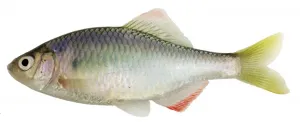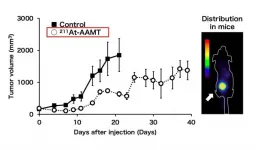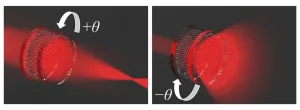(Press-News.org) HOUSTON -- Researchers from The University of Texas MD Anderson Cancer Center who profiled more than 45,000 individual cells from patients with peritoneal carcinomatosis (PC), a specific form of metastatic gastric cancer, defined the extensive cellular heterogeneity and identified two distinct subtypes correlated with patient survival.
Based on their findings, published today in Nature Medicine, the researchers developed and validated a gene expression signature capable of predicting patient survival better than other clinical features. If validated in prospective studies, this tool may be useful in stratifying patients with gastric cancer and directing them for more effective treatment strategies.
"In order to better treat patients with PC, we first have to understand the populations of metastatic cells in the peritoneal cavity," said co-corresponding author Linghua Wang, M.D., Ph.D., assistant professor of Genomic Medicine. "This is the most detailed analysis of these cells performed to date. That is the power of single-cell analysis - we are able to look at every single cell and get a picture of the landscape."
Peritoneal carcinomatosis is a condition in which cancer cells infiltrate and invade the peritoneal, or abdominal, cavity, adhering to the stomach and other organs. This can occur with other gastrointestinal cancers but is most commonly seen in patients with advanced gastric cancers, with roughly 45% of patients diagnosed with PC at some point. The condition leads to significant fluid accumulation in the abdominal cavity, and patients have an overall survival of less than six months.
"PC represents a major unmet clinical need, as we don't have effective treatment options available for these patients," said co-corresponding author Jaffer Ajani, M.D., professor of Gastrointestinal Medical Oncology. "Based on our findings, we need to move toward profiling these cells in each patient in order to offer more tailored treatment options."
For this study, the researchers isolated PC cells from ascites fluid collected from 20 patients with advanced gastric cancer. Ten of the patients were long-term survivors who survived more than one year after PC diagnosis, and 10 patients were short-term survivors who survived less than six months after PC diagnosis.
After performing single-cell RNA sequencing to analyze gene expression, the researchers were able to build the first "map" of PC cells, which describes the variety of cell types present and their functional states. The variability of cancer cells present within a tumor is known as intratumor heterogeneity, and it can lead to treatment failure and recurrence as distinct subtypes of cancer cells will respond differently to a given therapy.
The gene expression information also enabled the researchers to determine the origins of the PC cells, known as tumor cell lineage. They discovered that, although these were all gastric cancer cells, some appeared to originate from cells of the stomach while others more closely resembled cells of the intestine.
"The intriguing aspect is that, by classifying tumor cells based on lineage compositions, we noted two groups of patients," Wang said. "The more gastric-like PC cells had an aggressive phenotype and were associated with shorter survival. However, the more intestine-like PC cells were less aggressive, and patients had longer survival."
Based on these findings, the researchers developed a gene signature which robustly predicted patient survival better than various clinical features. They validated the signature in a second cohort of patients with advanced gastric cancer and PC and four large-scale localized gastric cancer cohorts totaling more than 1,300 patients.
Going forward, the researchers hope to validate the signature in prospective studies and to perform further analyses of PC cells in more patients to identify regulatory mechanisms of tumor cell lineage plasticity and new therapeutic targets that can be exploited to provide better treatment options for patients.
"This is an important first step toward a better understanding of the single-cell biology of these cancer cells, but we have more work to do," Ajani said. "We foresee that understanding this heterogeneity could one day be used to guide clinical decision making that is most beneficial to each patient."
INFORMATION:
The research was supported by MD Anderson, the Andrew Sabin Family Fellowship, the U.S. Department of Defense (CA150334, CA162445, CA160433, CA170906), the National Institutes of Health (S10OD024977-01, CA016672), the Schecter Private Foundation, the River Creek Foundation, the friends and family of Mr. Kevin A. Frankel, the Arthur B. & Marion Myers Trust Fund For Cancer Research, the Scott Petty Foundation, the Stupid Strong Charitable Foundation, the V Foundation For Cancer Research, The Ronnie James Dio Stand Up and Shout Cancer Fund, Mrs. Donna M. Milrod, the friends and family of Mr. Delmer W. Dallas, Mrs. Muna Ibrahim M. Al-Mousa and Dr. Abdul Aziz Sultan, the Park Foundation, the Carlos H. Cantu Family Foundation, and generous support from the Caporella, Smith, Frazier, Oaks, Vanstekelenburg, Planjery, McNeil and Hyland families.
In addition to Wang and Ajani, collaborating MD Anderson authors include: Ruiping Wang, Ph.D., Minghao Dang, Ph.D., Guangchun Han, Ph.D., Shaojun Zhang, Ph.D., Dapeng Hao, Ph.D., Shuangtao Zhao, Ph.D., Yuanxin Wang, Xingzhi Song, Ph.D., Yanshuo Chu, Ph.D., Jianhua Zhang, Ph.D. and Andy Futreal, Ph.D., all of Genomic Medicine; Kazuto Harada, M.D., Ph.D., Melissa Pool Pizzi, Meina Zhao, Ph.D., Ghia Tatlonghari, Mariela Blum Murphy, M.D., Namita Shanbhag, Ahmed Adel Fouad Abdelhakeem, M.D., and Shumei Song, M.D., Ph.D., all of Gastrointestinal Medical Oncology; Fang Wang, Ph.D., of Bioinformatics and Computational Biology; Yang Lu, M.D., Ph.D., of Nuclear Medicine; Brian D. Badgwell, M.D., of Surgical Oncology; Jeannelyn S. Estrella, M.D., and Sinchita Roy-Chowdhuri, MBBS, Ph.D., both of Pathology; Guang Peng, Ph.D., and Samir Hanash, M.D., Ph.D., both of Clinical Cancer Prevention; George A. Calin, M.D., Ph.D., of Experimental Therapeutics; and Alexander J. Lazar, M.D., Ph.D., of Pathology and Translational Molecular Pathology. Also collaborating on the study was Mingyao Li, University of Pennsylvania School of Medicine, Philadelphia, PA. All authors declare no conflicts of interest.
EUGENE, Ore. -- Jan. 4, 2021 -- Phosphorous, calcium and charcoal in spotty patches of fertile soil in the Amazon rainforest suggest that natural processes such as fires and river flooding, not the ingenuity of indigenous populations, created rare sites suitable for agriculture, according to new research.
The presence of pre-Columbian artifacts and signs of plant domestication uncovered in the region's fertile soil, commonly called Amazonian dark earth, had been thought to mean that agricultural practices, including controlled burning, by indigenous people had boosted soil nutrients.
However, radiocarbon dating ...
What The Study Did: Denmark was one of the first countries to enforce lockdown to reduce the spread of COVID-19 and subsequent gradual reopening, whereas Sweden has had few restrictions, largely limited to public recommendations. Researchers assessed public mobility and social media attention associated with COVID-19 spread and societal interventions from February to June in Denmark and Sweden.
Authors: Isabell Brikell, Ph.D., of the Karolinska Institutet in Stockholm, is the corresponding author.
To access the embargoed study: Visit our For The Media website at ...
What The Study Did: Researchers used health insurance data from Taiwan to investigate the risk of substance use disorder among patients with autism spectrum disorder and its associations with risk of death.
Authors: Chih-Sung Liang, M.D., of the National Defense Medical Center, and Mu-Hong Chen, M.D., Ph.D., of the Taipei Veterans General Hospital in Taipei, Taiwan, are the corresponding authors.
To access the embargoed study: Visit our For The Media website at this link https://media.jamanetwork.com/
(doi:10.1001/jamapediatrics.2020.5371)
Editor's Note: The article includes funding/support disclosures. Please see the article for additional information, including other authors, author ...
Bitterling fishes (Subfamily: Acheilognathinae) spawn in the gills of living freshwater mussels obligately depending on the mussels for reproduction. On the Matsuyama Plain, Japan, populations of unionid mussels--Pronodularia japanensis, Nodularia douglasiae, and Sinanodonta lauta--have decreased rapidly over the past 30 years. Simultaneously, the population of a native bitterling fish, Tanakia lanceolata, which depends on the three unionids as a breeding substrate, has decreased. Furthermore, a congeneric bitterling, Tanakia limbata, has been artificially introduced, and hybridisation and genetic introgression occur between them. Here, we surveyed the reproduction and occurrence of hybridisation between native and invasive species ...
Improving solar cell design is integral for improving energy consumption. Scientists have lately focused on making solar cells more efficient, flexible, and portable to enable their integration into everyday applications. Consequently, novel lightweight and flexible thin film solar cells have been developed. It is, however, not easy to combine efficiency with flexibility. For a material (usually a semiconductor) to be efficient, it must have a small "band gap"--the energy required to excite charge carriers for electrical conduction--and should absorb and convert a large portion of the sunlight into electricity. Till date, no such efficient absorber suitable for thin film solar cells has been developed.
Typically, charge carriers in a semiconductor are ...
Osaka, Japan - A cancer-specific L-type amino acid transporter 1 (LAT1) is highly expressed in cancer tissues. Inhibiting the function of LAT1 has been known to have anti-tumor effects, but there has been limited progress in the development of radionuclide therapy agents targeting LAT1. Now, a multidisciplinary research team at Osaka University has established a targeted alpha-therapy with a novel drug targeting LAT1.
The researchers first produced the alpha-ray emitter 211Astatine, no easy task given that Astatine (At) is the rarest naturally occurring element on Earth. Targeted alpha-therapy selectively delivers α-emitters to tumors; the advantage over conventional β-therapy is that alpha ...
The odd, wavy pattern that results from viewing certain phone or computer screens through polarized glasses has led researchers to take a step toward thinner, lighter-weight lenses. Called moiré, the pattern is made by laying one material with opaque and translucent parts at an angle over another material of similar contrast.
A team of researchers from Tokyo University of Agriculture and Technology, TUAT, in Japan have demonstrated that moiré metalenses--tiny, patterned lenses composed of artificial "meta" atoms--can tune focal length along a wider range than previously seen. They published their results on November ...
Mothers and fathers of children diagnosed with cancer are affected financially in different ways. While mothers' incomes fall in the short term and then rise, the adverse financial repercussions on fathers occur later. Researchers at Uppsala University have investigated the socioeconomic impact on parents of having a child diagnosed with cancer. The study is published in the International Journal of Cancer.
Previous research has shown that when a child falls ill with cancer, the parents are affected financially as well as psychologically. The available literature shows that mothers are more affected than ...
High-performance, eco-friendly, safe and at the same time cost-effective: the zinc-air battery is an attractive energy storage technology of the future. Until now, the conventional zinc-air battery has struggled with a high chemical instability, parasitic reactions which rooted in the usage of alkaline electrolytes lead to electrochemical irreversibility. Based on an innovative, non-alkaline, aqueous electrolyte, an international research team led by scientist Dr. Wei Sun of MEET Battery Research Center at the University of Muenster has developed a new battery chemistry for the zinc-air battery which overcomes the previous technical obstacles. The scientific team has published the detailed results of their research project, involving ...
December 31, 2020 - Data on COVID-19 transmission among Chicago youth - particularly in the city's extensive network of Catholic schools - supports a strategy for gradual reopening of the city's public school system, according to a report in the Journal of Public Health Management and Practice. The journal is published in the Lippincott portfolio by Wolters Kluwer.
"Data from the nation's largest Catholic school system reveals that implementation of layered mitigation efforts can support the goal of reopening in-person education in a safe but not zero-risk environment," write Marielle Fricchione, MD, and colleagues of the Chicago Department of Public Health (CDPH). Based ...





